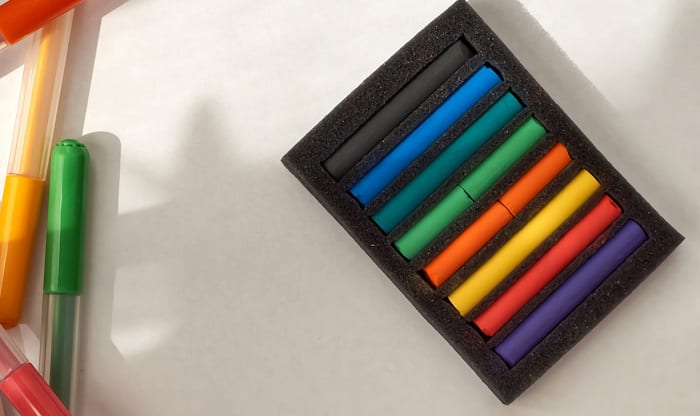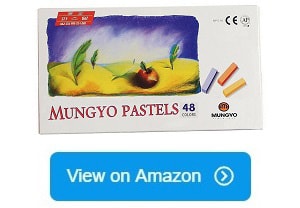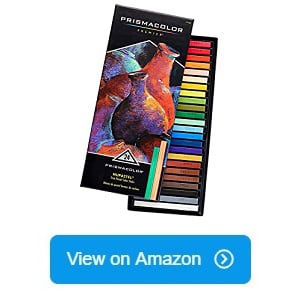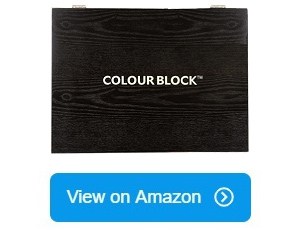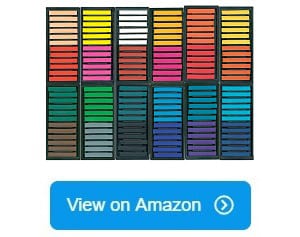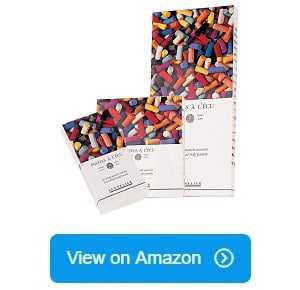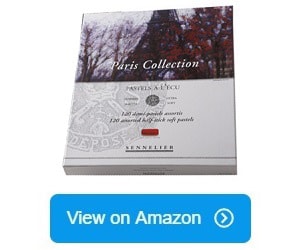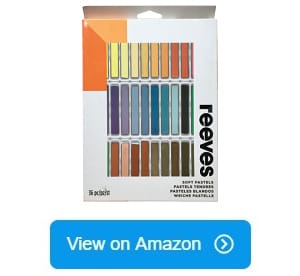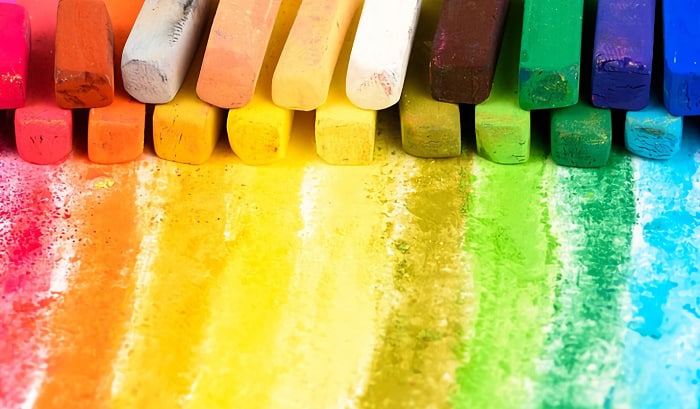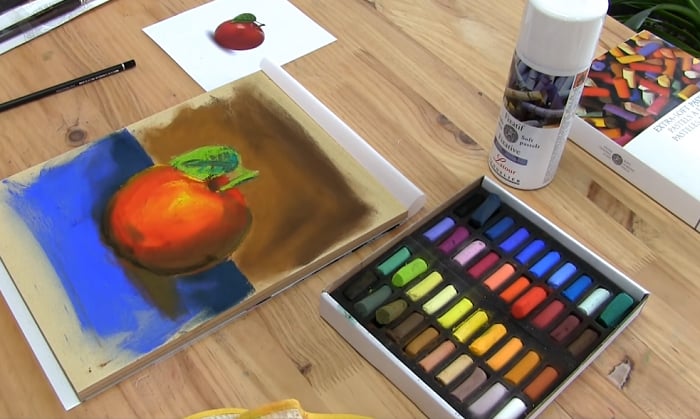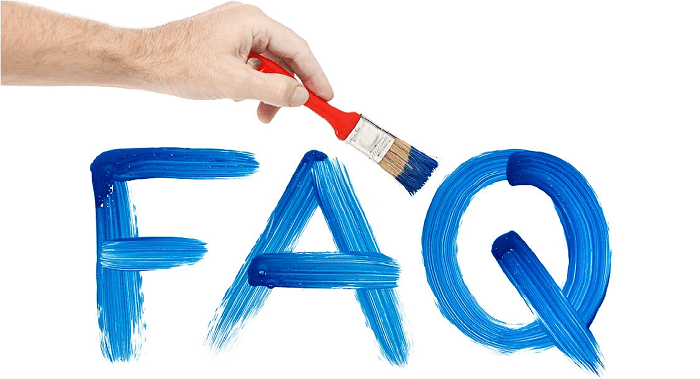There are many different ways to produce a mesmerizing visual art. Some artists choose to paint, while others through pencils. In addition, there are some artists who use digital platforms as their medium for their art. However, if you are a traditional artist, you know that nothing beats the pleasure of using the best soft pastels to transform your ideas into an inspiring piece of art.
If you are a novice who wishes to improve your pastel handling skill, you definitely need to learn more about the top-rated soft pastels for beginners. This way, you will be able to determine which brands to trust and avoid. This article will provide you with insights on how to choose the right brand of soft pastels for your artwork or for your practice.
Table of Contents
- Top 10 Soft Pastel Reviews
- 1. Mungyo Soft Pastel Square Chalk
- 2. Rembrandt Soft Pastels Starter Box
- 3. Faber Castell Creative Studio Soft Pastel
- 4. Non-Toxic Mungyo Soft Chalk Pastel
- 5. Prismacolor 27049 Premier NuPastel Firm Pastel
- 6. Colour Block Soft Pastels in a Deluxe Wooden Box
- 7. Sargent Art 22-1144 Colored Square Pastels
- 8. Sennelier 40 Half Pastel Boxed Set
- 9. Savoir-Faire Sennelier Soft Pastels
- 10. Reeves Soft Pastels Assorted
- What to Look for When Buying Soft Pastels
- Other Important Factors to Consider
- Frequently Asked Questions
- Conclusion
Top 10 Soft Pastel Reviews
1. Mungyo Soft Pastel Square Chalk
Pastels have always been my preferred medium for artful activities. This chalk pastel set is the most affordable and yet the most convenient tool to use at home while raising my children.
My kids love painting in pastels because there’s no need for brushes or palettes, their bare hands are enough for unlimited and creative artworks. There are no rules in using them so my kids tried mixing it with water. The different finish is very unique in its own way and has a small resemblance in watercolor painting. Now, we have an avalanche of colorful artworks displayed on the fridge and their bedrooms.
I remember receiving the package in good condition. The set was in a plastic fitted tray, shades of the same color sitting side to side. The wide range of hues was overwhelming and irresistible. My kids can’t get enough drawing animals and figures every day. These are very handy and very easy to use on plaid and Colourfix paper.
I love how it comes in great on my sketches, they are super vivid and clean. I only use my favorite three colors for layering portraits to make them look more effective and striking. Hands down to these pastels because it made the labels in our café more noticeable and interesting. I adorn our cafe walls with some of my sketches and I’ve had customers asking for the artist. Wow!
I also tried cross-hatching over an old acrylic painting. And I was impressed because it added texture and a shadow illusion using dark to lighter tones.
- Wide variety of vivid and pure hues (64 pieces)
- Easy layering and blending
- Easy to draw and soluble
- Less prone to fading
- The size is about an inch long
2. Rembrandt Soft Pastels Starter Box
Lots of things are changing so fast, but not my love for pastels. I’ve been working on a DIY project with the little ones to keep them occupied these days. I love how I didn’t spend a lot of money to get started with these soft pastels from Rembrandt. We got 15 soft pastel sticks to experiment and mix up. The lovely range and the very rich pigment is undeniably very eye-catching. My kids love it like candies! My husband who is into carpentry made some frames to showcase our personal artworks in the staircase gallery.
Now, here comes the fun part, creating a world of their own through painting! For starters, my kids made Kandinsky art. We enjoyed layering using different color combinations (mostly shades of blue and yellow). The edges are hard enough to draw big concentric circles and squares in detail. We put them together and they are quite stunning. We also created our own galaxy art on a black construction paper to make the color pop. And it did! Blending the rich colors using our fingers was messy but super fun.
Not only that, but the vibrant consistency is also medium soft, perfect for underlayer, and coverage on landscape backgrounds. These pastels also matched my waxy colored pencils. Both worked in-depth on portraits and still life sketches.
It’s cool that they do not produce too much dust compared to the students’ quality pastels I’ve used before. I also like that these are also non-toxic and safe.
I always bring some of my favorite sticks at work. Being a mother and running a business can be nerve-wracking and this medium keeps me sane.
- Suited for blending and layering colors
- Rich and pigmented color palette
- Non-toxic and safe for all ages
- Reasonably priced
- Prone to breaking if not handled properly
3. Faber Castell Creative Studio Soft Pastel
Raising my kids and growing my business at the same time is truly a high-pressure gig. Nonetheless, it doesn’t stop me from spending quality time with them. And the perfect medium for us is through painting and art stuff!
This was my starter kit when I took my first painting session in the uni. It was amazing how versatile this palette works on almost any surface. As I progressed, I added artist-quality colors to mix and match on canvas, boards, and textured paper. In fact, I’ve earned work commissions making dreamy landscapes and portraits way back.
The box still has the entire 72 lovely colors, though some are almost used up. It’s cool that we are able to get the exact color for our drawings without any disarray because the names and numbers can still be read on the backside cover. The earth tones (rich gray, green, and brown) are my all-time favorite! My kids love the bold and vibrant colors for abstract painting. We were also smitten by the soft effect of the pastels on our coloring books from Creative Haven. Blending it using cotton balls is satiating and the interesting designs were brought to life! I love how we can easily wipe and layer the colors in wide areas too.
Looking at my old paintings, I’m impressed that the vivid colors did not fade. I remember bringing this palette on our vacation in the Lake of the Ozarks. I painted the sunset and the directness of the pastel made it look like a dreamlike fantasy lake. One for keeps!
- Boasts extremely vibrant and intense hues
- Perfect for drawing fine details and coverage
- Easy to mix and blend
- Easy to carry palette (outdoors or travel)
- The miniature size is not advisable for anyone with big hands
4. Non-Toxic Mungyo Soft Chalk Pastel
I started teaching my 6-year-old son and a few of my friend’s preschoolers art last summer. Aside from the dough parlor set and eco-friendly oil paints, playon crayons and oil pastels were among their favorites. I let them choose any painting materials to unleash their creativity while ensuring they are free from harmful chemicals.
In addition, I ordered a few sets of the Mungyo soft pastel and I was surprised that it became an instant hit to the kiddos. The reason I chose this is that they are non-toxic and safe like the art materials we use in class. The great selection of vibrant colors was efficient for shading and layering fruits and flower drawings. These pastels are rich in pigments and versatile too. We freely mix them with liquid watercolors and the results are simply amazing, colorful, and fresh.
The square type size is very easy to use. Shading was a breeze because the pastels are soft and not too chalky. Using the edge of the pastels, we were able to make fine lines for figure drawings. We used acid-free rag paper to withstand the rubbing and blending of colors and at the same time prevent the artworks from yellowing. In our next session, we plan to use colored pastel paper for fireworks and space art. I’m sure it would be out of this world! My son loves the gorgeous colors and is very eager to use his palette on our driveway, instead of our sidewalk chalks. Uh-oh!
- Extremely vibrant and pigmented
- Non-toxic and safe for little ones
- Square type is good for shading and drawing
- Can be mixed to other painting media
- Size is roughly an inch
5. Prismacolor 27049 Premier NuPastel Firm Pastel
I enjoyed drawing and sketching using charcoal and graphite pencil during my younger years. I am truly proud of the family and pet portraits I made in our wall gallery. With lots of encouraging feedback, I decided to explore different mediums as I get older. I delved into the art of pastel painting and it became my way of managing stress whilst juggling my kids’ schedule and our family business.
My husband gave me a complete set of Prismacolor NuPastel as a present. I love how intense the colors are and I couldn’t think of any compact medium that can match them. I often use the Premier pastels because it is highly pigmented compared to the Scholar type. They’re not chalky and simply what I needed for landscape painting and portraiture. The shape and its hardness are helpful for broader strokes and finer lines. Sometimes I break it in half to use the edge for thicker lines and background shading. Yes, their color possibilities are quite addicting!
I’ve also used vine charcoal on a few sketches but they somehow look dull. Doubtful, I layered one using the warm tones, and boy I was in awe! I didn’t know it would work easily on a regular sketchpad. It was nice that I was able to control the value and color, making it more natural. Though layering is a bit limited I was able to build depth and accentuate the flat looking sketches. It was fun blending them on turpentine for a dimensional look on nature painting. All thanks to these super versatile creamy pastels. I was in love with the finished result which is relatively close to the painting.
- Not chalky and dusty so it’s easier to cleanup
- Water and solvent-soluble
- The creamy pigment is good for blending and layering
- Has a velvety and smooth finish
- Fixative alters color tones
6. Colour Block Soft Pastels in a Deluxe Wooden Box
I learned how to paint through my grandfather. He was the only accomplished artist in the family until I became his apprentice. It was the fondest memory I have for him and my kids happily agreed to get artsy and step away from technology every weekend.
In 2012, with a minimal start-up, my husband ventured to furniture makeovers, the rustic and industrial style while I do glass painting and handmade crafts to sell online. Working from home allows us to spend more time with the kids. It’s nice that there are countless mediums available to draw and paint nowadays. Their favorites are watercolors, acrylic, and pastel.
I ordered a set of Colour Block soft pastels for our art session. Oh my! I was impressed by the deluxe wooden box and the number of rich-colored pastels. It’s reasonably priced for a student’s grade set and it has all the vivid and subtle colors we need. By the way, the names are found at the back of the packaging box. When it comes to quality, it is quite good and the colors blend well together. We had fun trying these on boards and sandpaper too. The effects are very unique on each surface. My kids opted to use their cold-pressed watercolor papers, the coverage was surprisingly smooth on their abstract geometric art. I love how my favorite light-toned pastels got bolder through dark-toned papers. Wow! The soft edges made my Parisienne roses and dahlias stand out against the background!
- Contains 100 pure pigmented soft pastels
- Easy to make thin lines and soft bold lines
- Easy to blend on smooth and gentle surfaces
- Sturdy wooden box provides protection
- Some pastels don’t adhere to the paper easily
7. Sargent Art 22-1144 Colored Square Pastels
Arts and crafts were my sources of happiness before I got married. Now that I have a daughter who shares the same passion and business with me, I couldn’t ask for more. Both of us are self-taught, I prefer sketches and she does graffiti art painting. She always says it’s her way to connect to the community. Chalks and pastels were introduced to me after an international art fair in Iowa. I began freelancing using this medium for a year and have tried most commercially sold brands and then I discovered Sargent Art.
I have no regrets purchasing these colored square pastels. I love how fairly affordable this set was, considering the extensive range of colors in the box, a total of 144, and 6 each of 24 mixed colors. Imagine never running out of your most used colors. Oh, such bliss! The consistency is velvety and offers smooth coverage and soft effect. For the shape, it is easy to work with and the grip is ideal for beginners and perfect for chalk festivals. The gorgeous vibrant hues are perfect for a bold outline. Even when dry, there is less noticeable dust. Cleaning was so easy. It is also free from harmful chemicals. Hurray!!
I remember working on a project with my daughter for the opening of an outdoor café. She used her Butter chalk pastels as a base filler for my pastels. Surprisingly it is blendable too! The payoff of this experiment was worth it. These pastels complimented the glow in the dark chalks she used during the night. The freedom of using different mediums with my versatile go-to pastels is never-ending.
- Contains 144 rich pigmented square chalk pastels
- Has a dry and velvety consistency
- Not dusty even when dry
- Non-toxic
- Flimsy packaging
8. Sennelier 40 Half Pastel Boxed Set
As a working mother, arts and crafts became my outlet to feel relaxed and refreshed. As my kids are growing up, I encourage them to learn about the arts. My daughter took after my spouse who is into music and soccer. On the other hand, my son saw the beauty and fun of painting. This is a win-win for everyone, right?
Since we share the same passion, I let him take charge of our art projects at home. The first one we did is a corner wall gallery. We’ve played on several art mediums and the most loved sketches and portraits are made of pastels.
I’ve been using Sennelier soft pastels over the years and I’m still amazed at how it smoothly lays down on any textured surfaces. They are very lovely to work with, it’s like working with paint! What I really love about this set is they do not contain clay. It has a pure pigment which makes each half-stick extra soft, rich and creamy. The whites in particular. It has the same texture as Unison soft pastels but Sennelier’s quality is way above the former.
My son often used these on Sennelier pastel cards which work best on layering and his gentle portraitures. I preferred painting these pastels on the Colourfix’s earth tones. I’m obsessed with leaves and floral works and with these buttery pastels, they look more subtle and lush. In fact, I have several artworks decked on the walls of our real estate office which often draws my client’s interest.
- Contains 40 Artist quality Half Stick Soft Pastel
- Commissioned by Degas. Used by Picasso
- Has pure pigments and no clay
- Offers luminous and velvety tones
- Price not suitable for art students and beginners
9. Savoir-Faire Sennelier Soft Pastels
Having a quality set of soft pastels at your disposal is an assuring thought. When it comes to artworks, an artist should not settle for anything less than best. If you are an advanced artist or just a beginner, the Savoir-Faire Sennelier Soft Pastels will help you put your artistic vision into an awe-inspiring artwork!
I like this particular brand of soft pastel! It has a wide selection of colors. I can easily enrich the tone of my drawing because I have a variety of basic colors. In addition, the sticks are very easy to apply on any surface (yes, any surface). I have learned that this pastel works not only on paper but also on wood, metal, and glass surface.
Another thing that I like about this brand is that these pastels are very safe to use. All the sticks are acid-free, meaning that children won’t inhale bad smells which can affect their health anytime. If you are an art teacher, having an acid-free set of pastels in your classroom can really take a heavy burden in your mind.
- Works on various surfaces such as paper, wood, metal, and glass
- Bright pigment
- Acid-free
- Easy to use
- Colors are consistent with other brands
- Some sticks on the package crumble easily
10. Reeves Soft Pastels Assorted
If you are an artist who specializes in nature and animal sceneries, you need to have a good set of soft pastels in your collection. The assortment of colors in your pastel set will help you make your drawing as realistic as you want it to be. If you want to achieve perfection in your drawing, the best brand to help you is Reeves Soft Pastels.
There are so many things that I like about this particular brand of soft pastels. First is the wide assortment of colors. There are 36 color choices in the package. Next, the fact that the sticks are very easy to use is so appealing to me. Even beginners will be able to use it without any difficulty during their practice sessions.
In addition to what I have mentioned above, I like the fact that this set has plenty of earth tones. Colors such as salmon, light brown, mid-brown, charcoal, burnt sienna, raw umber, and others are included in the set. With these colors at my disposal, I can make my nature and animal drawings as realistic as possible.
- Wide range of colors
- Easy to use
- Earth tones included
- Color spreads evenly
- Too dusty
What to Look for When Buying Soft Pastels
Pastels can be purchased in various types: hard, soft, chalk, pastel pencils, Panpastels, and oil. Each of these types has its own distinctive characteristics. If you are an artist, these selections can suit your specific needs. However, not all pastel brands offer the same quality color, texture, and other elements that an artist wants on his art. If you are going to shop for soft pastels, you need to study each and every brand’s features.
Here are some of the things that you need to look for when buying soft pastels:
- Quality. For those who didn’t know, there are two grades of soft pastels that you can buy: the artist’s quality and the student’s quality. If you think that your skill is above a beginner’s you can certainly use the artist’s quality. However, if you feel that your skill is just developing, then you should use the student’s quality.There is a basic difference between the artist’s and student’s soft pastel quality. A student’s quality uses imitation pigments to mimic the color and tone of a certain color. As for the artist’s quality, all the pigment used to make each color is authentic and more expensive to produce. This is the reason why a student’s quality is more affordable than an artist’s quality.
- Colors. Soft pastels have a wide variety of color choices. You can either purchase one particular color independently or purchase a whole set. If you are a beginner, you need to purchase only the basic colors to practice on. Once you get the hang of layering and blending techniques, you can now expand your color selection.The colors of your soft pastel must be carefully selected. Having different shades of one color will allow you to enrich the tone of your drawing. The color names are printed on the cover so that you won’t confuse it with other similar colors on the package.However, there are some colors that are more expensive compared to others even if they come from the same brand. This is due to the fact that some pigments are more difficult to produce. This is the reason why students’ quality has standard pigments which imitate the pigment of expensive natural pigments. The only way to determine if your pastel is the cheaper one is if the name has the word “hue” on it.
- Safety features. Soft pastels may not look dangerous, but it can still cause considerable health damage if it is not handled properly. While soft pastels’ ends are not too pointed that it can cause punctures, children can still inhale the fine dust. If the dust finds its way into the lungs, it will surely cause serious complications such as lung cancer.If you are working with soft pastels, make sure that you use a facemask to prevent yourself from inhaling the fine dust particles. If a facemask is not available, make sure that the place where you are working is well-ventilated. This will ensure that the dust is blown far away from you.
Knowing these features before purchasing a certain soft pastel brand will give you the convenient and safe use of this product. In addition, it will help you save a great deal of money especially if you are still a beginner. Before deciding to purchase a set of soft pastels, make sure that you conduct research. This way, you will know which brand has the highest quality, widest color selection, and safest to use.
Other Important Factors to Consider
What is a soft pastel?
Soft pastels are considered to be the most traditional form or type of pastels. This is also the most used type of pastel compared to the other types. Compared to the other types, they have a high amount of pigment that is bonded together by the least quantity of gum binder. Because of this, soft pastel easily crumbles when touched. However, soft pastels have the most intense color and easy to use. This is the reason why most visual artists choose soft pastels to execute their colorful ideas to paper.
How does it work?
At first glance, we can see that pastels are simple to use. But truth be told, they are very versatile. Pastels, most especially the soft pastels, are great coloring tools. If you wish to get a painting effect on your artwork, this is the one that you should get.
For a beginner, you might be wondering how soft pastels work. Learning how it works will help you maximize its use in your art projects.
Physically speaking, soft pastels come from a pigment held together by a binder to provide them their stick-like shape. Unlike the oil pastels, soft pastels do not need any kind of solvents to blend. The bendable feature of soft pastels makes it very ideal for exploring coloring techniques and provide a way for anyone to come up with their own methods.
The common technique for using soft pastels is by rubbing it on the surface of a paper as many times as needed. Then, spread the color finely using a soft tissue paper.
Who is this for?
Contrary to popular belief, pastels are not only for professional artists. It can also be used by students for their art projects. With soft pastels, students can learn how to control the intensity of colors needed to produce the picture or image that they want to show.
People who are in therapy can also help them express their emotions without saying anything. In addition, people who are suffering from low self-esteem can also benefit from art therapy. For this kind of therapy, soft pastels are always around to help them put their thoughts and feelings into one concrete and colorful image.
What are the different types of pastels?
There are different types of pastels. As an aspiring artist, you certainly need to learn these types so that you can maximize the use of each one in your art projects.
Basically, there are five types of pastels. These are hard, soft, oil, pencil, and PanPastels.
- Hard pastel. Hard pastels are considered to be the most stable pastel. Because of its hard composition, it can be sharpened in order to make fine lines in the drawing.
- Oil pastel. Oil pastels, on the other hand, provide the look and texture of real paint. The only difference is that oil pastels do not have the harsh smell of paint typically has.
- Soft pastel pencils. Pencil pastels are for more controlled and detailed drawings. This particular type of pastel has the shape of a conventional pencil. But what’s encased inside is a mixture that has the consistency of both hard and soft pastel.
- PanPastel. PanPastels are another version of soft pastels but only served in a pan or tray. This type of pastel has less binder and more pigment, meaning you can enrich your drawing’s color in an even manner. The packaging also allows you to have less waste and transport it conveniently.
- Soft pastels. Soft pastels are considered to be the traditional form of pastels. It has a high content of pigment that is brought together by a little amount of binder to give it a soft texture. The softness provides this type of pastel the versatility needed for layering or blending colors to bring out a painting effect.Moreover, soft pastels come in thick sticks, whole sticks, and half sticks. It can be purchased individually or in a package. However, if you have only just begun practicing, it is advisable that you buy a balanced palette that you can build as you improve your skill.
Now that you have an idea about the different types of pastels, you can purchase the specific type which will suit your artistic needs. Buying the wrong one will surely result in a waste of time, money, and effort.
Why do you need soft pastels?
If you are an aspiring artist, you certainly need all the practice before executing an awe-inspiring piece of artwork. As a matter of fact, all great visual artists started their journey by practicing their coloring techniques. If your medium is soft pastel, you have to be adept at using it before you can produce a stunning piece of art.
With good soft pastels in your hand, the only limit is your own imagination!
Frequently Asked Questions
What are the most trusted soft pastel brands?
There are many brands of chalk pastels for beginners available in the market these days. While most of these brands are considered to be affordable, only a few can be considered to be worth their salt.
Here are some of the most favorite chalk pastels that you can consider and eventually include in your shopping list:
- Faber Castell
- Terry Ludwig
- Art Spectrum
- Rembrandt
- Prismacolor
- Colour Block
- Mungyo
- Sargent Art
- Reeves
These brands have passed the inspection of satisfied customers all over the United States. If you want to have the top-rated pastel-based artwork, these brands can definitely provide you the finest quality your artwork deserves.
Are soft pastels the same as chalk pastels?
Beginners usually confuse chalk pastels and soft pastels. When buying their art supplies for the first time, some usually end up purchasing chalk pastels.
There is a major fundamental difference between chalk pastels and soft pastels. Chalk pastels are enriched with water. Meanwhile, soft pastels are rubbed in order to get the proper texture and look. Soft pastels easily transfer to the medium, which is why these are the best pastels for beginners.
However, there are some soft, chalk pastels available, too! So make sure you read the product description carefully before purchasing.
What are soft pastels used for?
If you are using soft pastels for the first time, you might find it very difficult and messy to incorporate into your artwork. However, to maximize the effect of this art tool on your art project, you need to learn its function.
Soft pastels are mainly used for layering and/or blending different colors in order to achieve a painting effect. Professional artists have no trouble achieving this effect on their artworks. For a complete beginner, however, regular practice using a reliable brand of soft pastels for artists will slowly instill this skill.
How do you use soft pastels?
Using a soft pastel to successfully integrate it into an artwork requires a well-developed skill. You can achieve this by regularly practicing your blending and layering techniques.
Here’s how to blend colors using soft pastels:
- On a clean piece of paper, rub a pastel color of your choice. For instance, if you wish to achieve orange, rub a yellow pastel generously. Rub the pastel in a unidirectional manner.
- Next, rub a red pastel on top of the yellow one. Again, do it in a unidirectional manner.
- Using a tissue or just simply your index finger, gently rub the layers of pastel until it blends together. You will begin to see an orange color immediately.
Before using the pastels, make sure that you choose the paper with the right surface and tone. The right paper surface will make sure that the pastel will adhere to it while the paper tone will prevent the pastel from giving out an unexpected color combination in the process.
Where to buy?
You can buy soft pastels in every art supplies shop near you. You can also buy it in Walmart, Lowes, and other supermarkets.
However., if you can’t find your preferred brand in any of these stores, you can always visit an online store. Amazon.com is a perfect online store where you can choose the right soft pastels for your artwork. Not only will you be able to learn a great deal about the product, but also learn more about how it performs under various conditions. This way, you can have a better judgment when you decide to purchase the soft pastel brand of your choice.
How to care and clean?
Learning how to take good care of your soft pastel will help you prolong its life expectancy. It is only natural to expect that the pastel will run out the more you use it. However, if the pastels went bad even if you are not using it, then it means that you are not taking good care of it.
Here are some things that you can do to take care of your soft pastels:
- Avoid touching the pastel.
- Avoid leaving the pastel in direct sunlight.
- Avoid leaving it in moist areas.
- Always put it back on the package after use.
Knowing how to take care of your soft pastels will save you money in the long run. This is because as you improve your skill, you will certainly need more pastel to use in your artwork. Buying another set just because you ran out of a particular shade is not only impractical but also a total waste of resources.
Conclusion
Buying the best soft pastel set for the first time is definitely a tricky task. There are many complicated things to know before you can make a successful purchase. This is the reason why you should conduct research before spending money on a soft pastel. However, once you have learned more about the quality, color selection, safety features, and other important things, you will be able to choose the right brand immediately.
Once you have the right pastel brand, you will be able to hone your skills. Finally, do not be afraid to make mistakes! Explore every possibility and use the pastels as you see fit. By the time that you are done with one set, your skills have surely improved by leaps and bounds.

I am a former art teacher, so it is evident to me the importance of art in educating the new generation. We also want to help parents who plan to teach their children and desire the best tools and tips for them.
